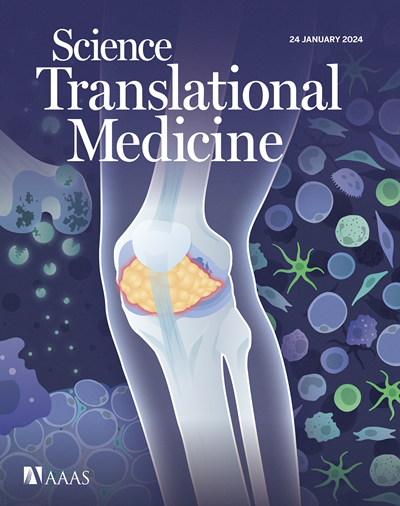TRIM15 drives chondrocyte senescence and osteoarthritis progression
IF 15.8
1区 医学
Q1 CELL BIOLOGY
引用次数: 0
Abstract
Osteoarthritis (OA) is a prevalent joint disease characterized by pain, disability, and loss of physical function, posing a challenge to public health. However, molecular mechanisms of OA pathogenesis have not been fully described. We report that tripartite motif containing 15 (TRIM15) is a regulator in chondrocyte senescence and OA. Our study revealed heightened expression of TRIM15 in chondrocytes of senescent cartilage from patients with OA and in aged wild-type mice. Using gain- and loss-of-function studies, we found that TRIM15 facilitated human chondrocyte senescence. Conditional deletion of Trim15 in mouse chondrocytes severely impaired skeletal growth, partially because of impaired embryonic chondrocyte senescence. Compared with conditionally knocked out Col2a1-CreERT2/Trim15flox/flox mice, Trim15flox/flox control mice exhibited accelerated OA phenotypes, increased senescence markers, and senescence-associated secretory phenotype during aging. Mechanistically, TRIM15 bound with yes-associated protein (YAP) and mediated K48-linked YAP ubiquitination at K254, which interrupted the interaction between YAP and angiomotin, leading to enhanced YAP nuclear translocation. Dysregulation of TRIM15-YAP and transcriptional coactivator with PDZ-binding motif (TAZ) signaling promoted OA progression in both the surgery-induced and natural aging–induced mouse OA model. Intra-articular injection of adeno-associated virus 5 (AAV5)–Trim15 shRNA decelerated OA progression in mice. In particular, YAP and TAZ protein amounts were increased in chondrocytes of patients with OA. Our preclinical results demonstrated that the AAV5-TRIM15 shRNA treatment protected human OA explants against degeneration through inhibiting chondrocyte senescence. Together, our findings underscore the potential of targeting TRIM15 in reshaping the aging cartilage microenvironment and suggest a promising therapeutic avenue for OA.
TRIM15驱动软骨细胞衰老和骨关节炎进展
骨关节炎(OA)是一种以疼痛、残疾和身体功能丧失为特征的普遍关节疾病,对公众健康构成了挑战。然而,OA发病的分子机制尚未得到充分的描述。我们报道了tripartite motif containing 15 (TRIM15)是软骨细胞衰老和OA的调节因子。我们的研究发现TRIM15在OA患者和老年野生型小鼠的衰老软骨软骨细胞中表达升高。通过功能获得和功能丧失研究,我们发现TRIM15促进了人软骨细胞衰老。小鼠软骨细胞中Trim15的条件缺失严重损害了骨骼生长,部分原因是胚胎软骨细胞衰老受损。与条件敲除Col2a1-CreER T2 /Trim15 flox/flox小鼠相比,Trim15 flox/flox对照小鼠在衰老过程中表现出加速的OA表型,增加的衰老标志物和衰老相关的分泌表型。在机制上,TRIM15与yes-associated protein (YAP)结合,介导k48相关的YAP泛素化,从而中断YAP与血管运动素之间的相互作用,导致YAP核易位增强。TRIM15-YAP和带有pdz结合基序(TAZ)信号的转录共激活因子的失调在手术诱导和自然衰老诱导的小鼠OA模型中都促进了OA的进展。关节内注射腺相关病毒5 (AAV5) - Trim15 shRNA减缓小鼠OA进展。特别是,OA患者软骨细胞中YAP和TAZ蛋白含量增加。我们的临床前研究结果表明,AAV5- TRIM15 shRNA处理通过抑制软骨细胞衰老来保护人类OA外植体免受变性。总之,我们的研究结果强调了靶向TRIM15在重塑老化软骨微环境方面的潜力,并为OA提供了一条有希望的治疗途径。
本文章由计算机程序翻译,如有差异,请以英文原文为准。
求助全文
约1分钟内获得全文
求助全文
来源期刊

Science Translational Medicine
CELL BIOLOGY-MEDICINE, RESEARCH & EXPERIMENTAL
CiteScore
26.70
自引率
1.20%
发文量
309
审稿时长
1.7 months
期刊介绍:
Science Translational Medicine is an online journal that focuses on publishing research at the intersection of science, engineering, and medicine. The goal of the journal is to promote human health by providing a platform for researchers from various disciplines to communicate their latest advancements in biomedical, translational, and clinical research.
The journal aims to address the slow translation of scientific knowledge into effective treatments and health measures. It publishes articles that fill the knowledge gaps between preclinical research and medical applications, with a focus on accelerating the translation of knowledge into new ways of preventing, diagnosing, and treating human diseases.
The scope of Science Translational Medicine includes various areas such as cardiovascular disease, immunology/vaccines, metabolism/diabetes/obesity, neuroscience/neurology/psychiatry, cancer, infectious diseases, policy, behavior, bioengineering, chemical genomics/drug discovery, imaging, applied physical sciences, medical nanotechnology, drug delivery, biomarkers, gene therapy/regenerative medicine, toxicology and pharmacokinetics, data mining, cell culture, animal and human studies, medical informatics, and other interdisciplinary approaches to medicine.
The target audience of the journal includes researchers and management in academia, government, and the biotechnology and pharmaceutical industries. It is also relevant to physician scientists, regulators, policy makers, investors, business developers, and funding agencies.
 求助内容:
求助内容: 应助结果提醒方式:
应助结果提醒方式:


